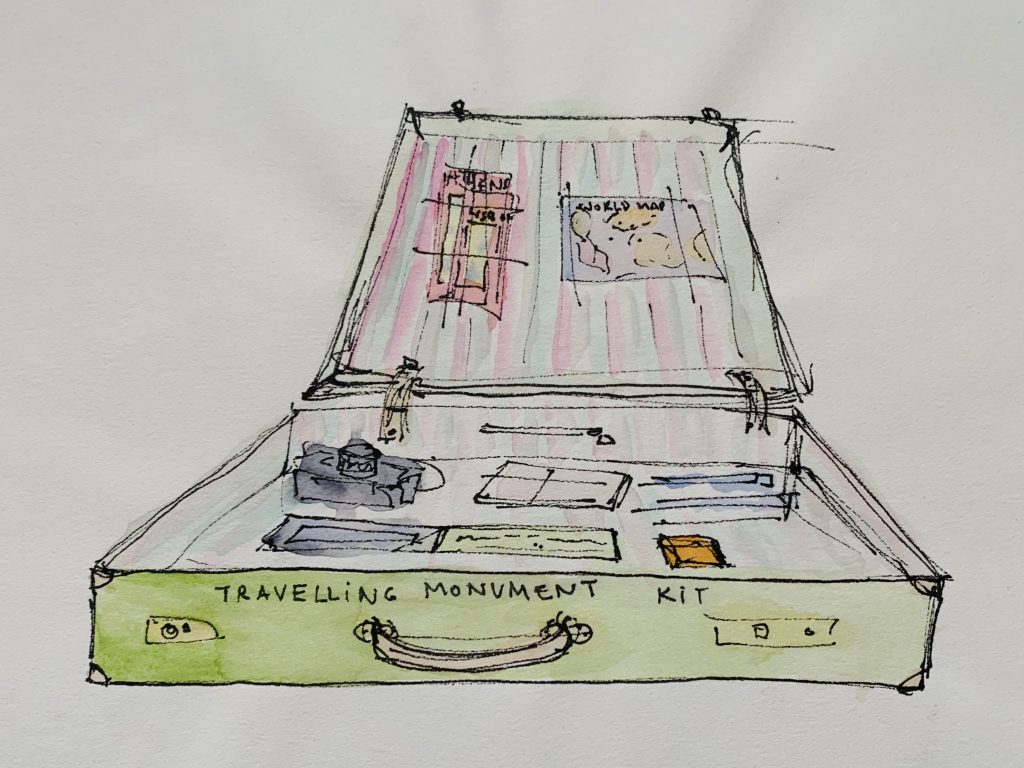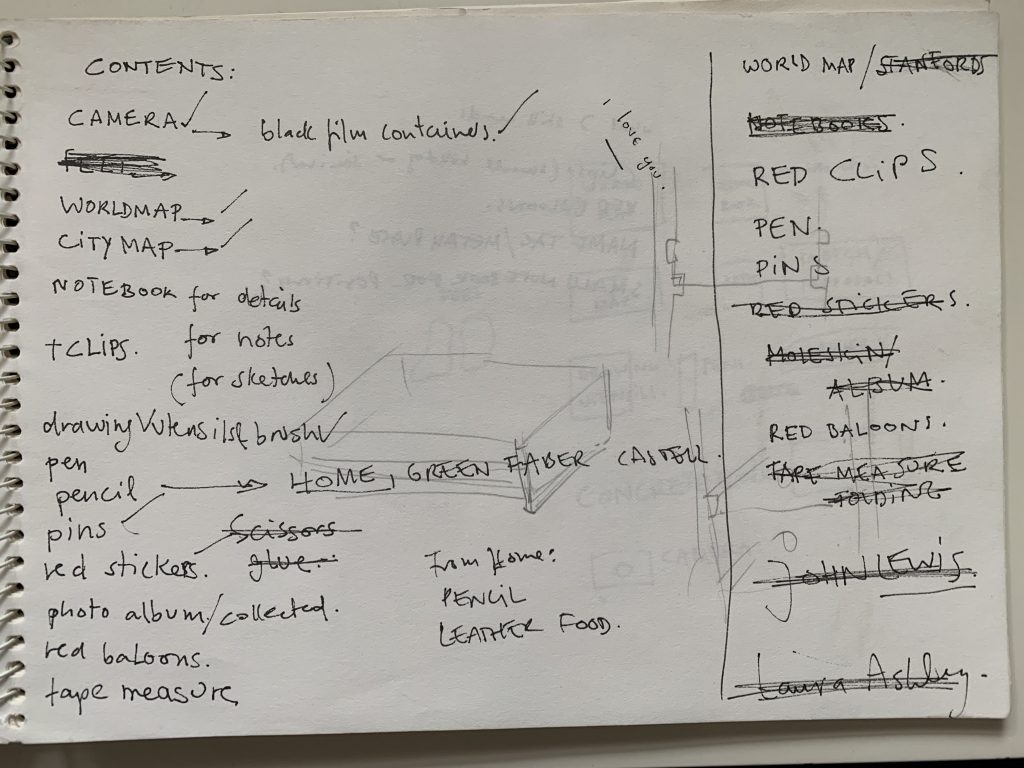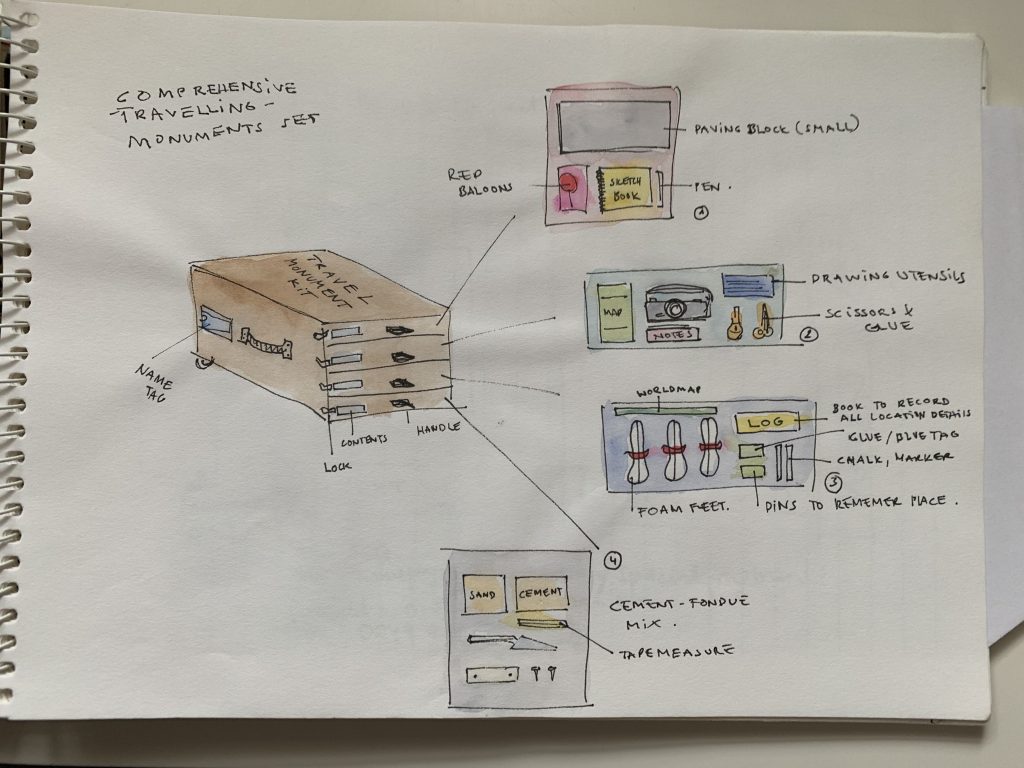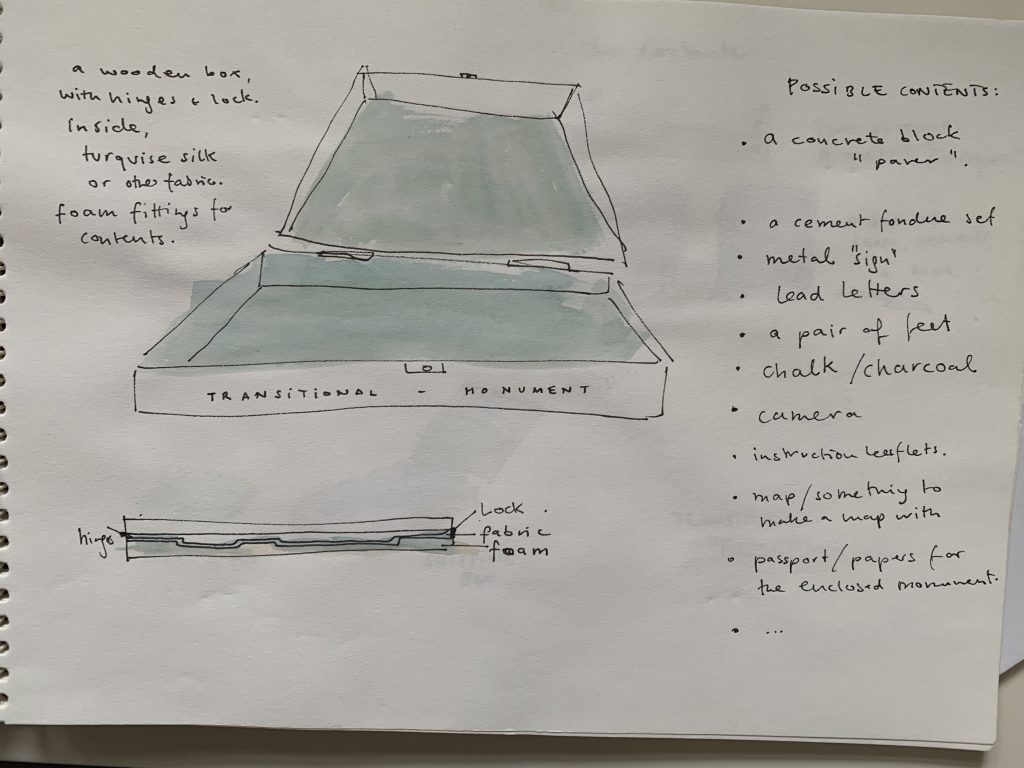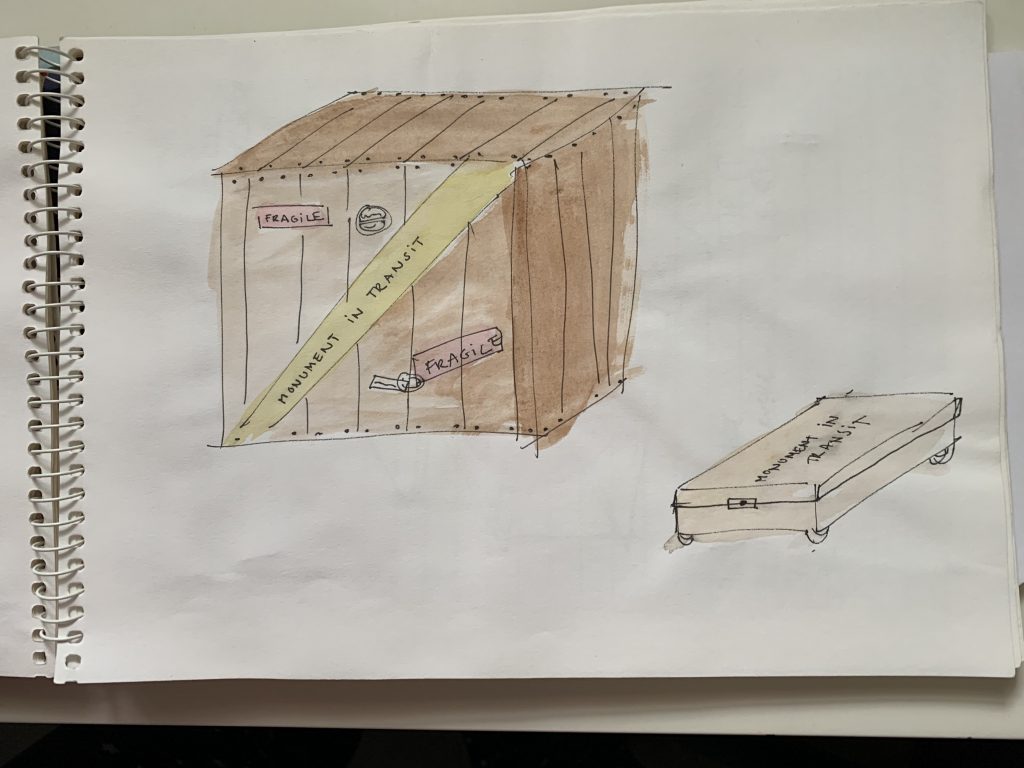Signpost: This is a post from the Neon Flaneuse blog. The Neon Flaneuse is a blogging project for which I write about art, anthropology and edtech. It’s part of my professional practice but a project I pursue in my own time.
Nearly two decades ago I had an idea to create a Travelling Monument Kit. This is the original drawing which I still have in a sketchbook somewhere even though the actual suitcase I made has been lost in the mists of time (read: one too many house moves).
The idea of the travelling monument kit is really a layered metaphor, several ideas wrapped into each other, so let me try and unpack it for you.
Note: From here you proceed at your own risk… this is a post about a half remembered artwork on a blog about an imaginary character.
At the heart of the Travelling Monument Kit, what originally got me thinking about this idea, is the relationship between travelling and permanence. Travelling is all about leaving things behind, discovering new ones and changing perspectives… it’s about change. Monuments are normally fixed in place and time, permanent markers of things to be remembered. They signify that which we don’t want to change or forget or leave behind.
The Travelling Monument Kit contained maps, both a world map to put pins/markers on the chart and track the overall route, to record places visited; it included a camera to take photos of the travelling monument (the physical artwork included a Polaroid camera); a plaque with text to affix to or mark the monument on location; an album for recording and collecting the monuments.
I’m not sure anymore whether I originally imagined there to actually be anything else in the suitcase, or whether any given object or place identified could simply become a monument by virtue of the process of making it so, putting up the plaque, taking pictures, recording it and so forth. In real life I did both, create those kinds of monuments as well as choosing an object to actually travel with in the physical sense.
(The object I chose for that purpose was a pair of swimming flippers. Why? Because there was a beach underneath the city streets that I was interested in finding.)
In a way the Travelling Monument Kit explores how we can create lasting meaning amidst change. The process of ‘making a monument’ is very similar to, for example, going to a familiar restaurant in unfamiliar surroundings or finding connections between landscapes we are familiar with in a new place that is strange and different. It’s about creating something solid and strong, a connection, to bring things into perspective.
The Travelling Monument Kit is also in a suitcase. And that was a deliberate choice as well as being integral to the idea. It’s important that it’s a suitcase. It’s important in a number of different ways: a suitcase is purpose built for travel. It’s a native travel object. It is designed to be at home whilst travelling in a way very few things are. It’s never not at home because it (by definition) contains everything within it. Also, a suitcase is made to be in transit, on the road. In contrast to objects like first aid kits which are usually fixed in place and purpose, a suitcase is flexible both conceptually and practically. In the context of the Travelling Monument Kit it signifies that you can take the ability to create your own monuments, your own lasting meaning, memories and connections with you. You can pack it in a suitcase and never be without it.
The physical dimension is important, too. It’s important that the process isn’t digital, but focused on visual and material things. It makes a difference that the traveller, the monument maker, undertakes a physical, practical process. It’s important for the same reason as visiting physical monuments in the real world is distinct from seeing visual or digital representations of them. The sensory and embodied practice of interacting with a specific place or object is key to creating the connection, to making a memory, to establishing meaning. It’s particularly important for a traveller because our physical bodies can often be out of sync with new time zones or sleeping patterns, food, smells, perspectives. It can be disorientating to experience a lot of change, to encounter a lot of new places or people in quick succession. It’s necessary to relate to what we encounter with our senses and physical selves in order to make sense of things.
That’s where the historical dimension of the monument idea comes in. It’s about creating order, a timeline, it’s about finding a narrative, a story that connects the new markers we place on our map and brings them into perspective. It helps us create our own histories, to make sense and determine the meaning of things to us and in the context of our own internal worlds. It’s a lot like writing, I suppose, but also more than that.
The Travelling Monument Kit is not an instant monument kit. It’s not about appropriation. Technology and the tech industry keep looking for shortcuts to creating a sense of history, of legitimacy, of belonging in our lives. This artwork is not about quick ways to create the look of the thing – even though some of its elements are very visual, like taking a photo, putting up a plaque etc. It’s about a process, about experience and embodiment. At the time when I made this I didn’t own a mobile phone yet. I neither had nor dreamt of the affordances of such digital tools as are now commonplace. But even if I had done so, I don’t think it would have mattered that all physical elements of the Travelling Monument Kit could now be easily replicated or approximated with my phone. A camera, a custom map, a plaque, a photo album or record… I could easily replicate the look of the thing, make an app, an Instagram account. But it would be something entirely different from the original.
The intention that shaped the making of this Traveling Monument Kit was not focused on what it would create, although I did end up creating some travelling monument ‘books’. It wasn’t about creating and sharing content. The intention was to articulate, to think through the ideas, to create a sense of belonging whilst travelling, whilst being in flux and to foster that ability within yourself.
All themes that I still think about two decades later and which have developed new, interesting dimensions since.
In the sketchbook that the original drawing is from, you can follow the development of the idea:
The Travelling Monument Kit itself is the final drawing in that sketchbook, after that there are only some blank pages. It’s as if the train of thought that had led to the drawing came to a full stop. The idea was created. I hadn’t thought about that before, how appropriate it was that the sketchbook ends after that drawing. It’s a useful thing to keep our own archive sometimes, to be able to go back and look at the physical objects that shape your thinking. Searching through my desk drawer revealed another interesting clue as to where my thoughts went next (this next sketchbook was probably bought in London but travelled to Athens where I was living at the time and back again and has followed me through all the house moves since 2002): the cover says it all: the suitcase files – travel accessories as metaphor.
Soundtrack for this post:
Dusty in Memphis by Dusty Springfield
Also…
